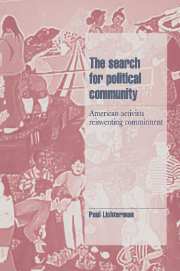Book contents
- Frontmatter
- Contents
- Acknowledgments
- 1 Personalism and political commitment
- 2 Personalized politics: the case of the US Greens
- 3 Speaking out in suburbia
- 4 Imagining community, organizing community
- 5 Culture, class, and life-ways of activism
- 6 Personalized politics and cultural radicalism since the 1960s
- 7 The search for political community
- Appendix I Choosing and studying the organizations
- Appendix II Why participant-observation was necessary
- Notes
- References
- Index
7 - The search for political community
Published online by Cambridge University Press: 23 January 2010
- Frontmatter
- Contents
- Acknowledgments
- 1 Personalism and political commitment
- 2 Personalized politics: the case of the US Greens
- 3 Speaking out in suburbia
- 4 Imagining community, organizing community
- 5 Culture, class, and life-ways of activism
- 6 Personalized politics and cultural radicalism since the 1960s
- 7 The search for political community
- Appendix I Choosing and studying the organizations
- Appendix II Why participant-observation was necessary
- Notes
- References
- Index
Summary
POTENTIALS AND LIMITS IN PERSONALIZED POLITICS
What are the prospects for personalized politics? What does a focus on commitment teach us about the conditions for a democratic grassroots community of different social change movements working together? It is time to take an accounting of personalized politics, and then to use those observations to speak back to the radical democratic visions introduced in Chapter 1.
Personalized politics takes on some challenges more effectively than others. The activists who practice it have raised broad moral and political questions about ecologically sound lifestyles, basic gender inequalities, and the priorities of industrialism that do not often get raised in institutionalized forums. These activists maintain a broad vision and are willing to talk publicly about it, which is no mean feat in a society increasingly habituated to media cynicism and the constraining “realism” of interest group politics. And these activists have sometimes carried out unquestionably “political” action in the most traditional sense of the term – electoral organizing, for instance – along with protests and public education campaigns. For all of these reasons, personalized politics has been an important, even vibrant, part of the grassroots political landscape since the 1960s.
A strong feature of personalized politics has been its dedication to inclusive participation. Of course, a community of individually articulate activists is one fenced in by social parameters of the sort examined in Chapter 5. Lucille Davis and Mrs. De Rose chafed at HAT's lack of space for individuals to make a difference in HAT, but it is unlikely they would have felt comfortable among the self-empowered political virtuosos at a Green meeting.
- Type
- Chapter
- Information
- The Search for Political CommunityAmerican Activists Reinventing Commitment, pp. 213 - 230Publisher: Cambridge University PressPrint publication year: 1996

